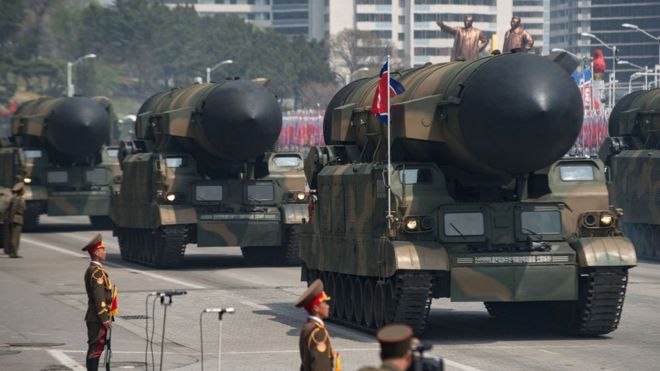North Korea has carried out another ballistic missile test, days after a new president took office in the South.
Japanese officials say the missile, which launched from north-western Kusong, reached an altitude of 2,000km.
South Korea’s newly elected President Moon Jae-in, who is seeking deeper engagement with the North, said it was a “reckless provocation”.
US President Donald Trump has called for “stronger sanctions” against North Korea, while China is urging restraint.
A series of North Korean missile tests this year – which are banned by the UN – has sparked international alarm and raised tensions with the US.
Two missile launches last month both failed, with the rockets exploding just minutes into flight.
The nature of the launch is still being determined, but analysts have said the test could suggest a longer range than previously tested devices.
The Japanese defence minister said it flew for about 30 minutes before falling in the Sea of Japan and could be a new type of missile.
Tomomi Inada said it covered a distance of about 700km (435 miles), reaching an altitude of more than 2,000km (1,245 miles) – higher than that reached by an intermediate-range missile North Korea fired in February.
Experts quoted by Reuters say the altitude meant the missile was launched at a high trajectory, limiting the lateral distance it travelled. They say if it had been fired at a standard trajectory, it would have had a range of at least 4,000km.
The US Pacific Command said in a statement the type was being assessed but that its flight was not consistent with that of an intercontinental ballistic missile [ICBM], which would have the range to reach the US mainland (more than 6,000km).
North Korea is believed to be developing two types of ICBM, but neither has so far been flight tested.
Mr Moon hosted an emergency meeting of his security council in the wake of the launch.
“The president said while South Korea remains open to the possibility of dialogue with North Korea, it is only possible when the North shows a change in attitude,” his spokesman said.
Meanwhile, a member of South Korea’s ruling party attending a major summit in China reportedly told the North Korean delegation directly that they “strongly condemned” the launch.
The White House said President Donald Trump “cannot imagine Russia is pleased” because the missile did not land far from Russian territory.
It added that the new launch should serve as a call for stronger sanctions against North Korea.
A Kremlin spokesperson later said Russian President Vladimir Putin was concerned by the test.
China, North Korea’s only major ally, called for restraint by “all relevant parties” in the wake of the latest test.
The North has conducted five nuclear tests despite UN sanctions and is also developing long-range missiles.
It is reported to be continuing efforts to miniaturise nuclear warheads and fit them on missiles capable of reaching the US.
Washington has accused other UN Security Council members of not fully enforcing existing sanctions against the North, and has urged China in particular to use its trade links as influence.
But despite poor relations, North Korea recently said it would hold talks with the US “if the conditions were right”.
The comments, by a senior North Korean diplomat, came after US President Donald Trump said he would be “honoured” to meet the North’s leader, Kim Jong-un.
Source: BBC


